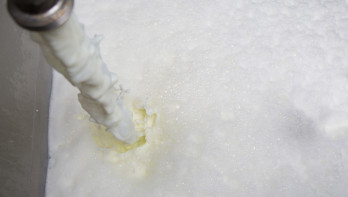News David Kennedy
Bord Bia: 'Recovery of Irish milk production on the horizon'
The wet weather during the first months of 2024 poses significant challenges for Irish dairy farmers. Production remains well below previous years. "Despite the sharp decline, there is confidence in a swift recovery in production," says David Kennedy, head of dairy at the Irish export organization Bord Bia.
In February 2024, Irish milk deliveries amounted to over 340,000 tons. Compared to nearly 393,000 tons in February 2023, this marks a significant decline. "Irish milk production in the first two months of this year is 13% lower than the same period last year," Kennedy explains. What is happening within the Irish dairy sector?
The Irish milk production is declining compared to last year. What is causing this?
"The main factor hindering milk production earlier this year was the wet weather. The Irish dairy system is largely grass-fed. When a cow eats more grass, its production increases. But last February was the wettest in years. March was not great either. Getting the cows out early this year simply wasn't feasible."
"Secondly, our calves arrived later than usual. This traces back to 2022 when milk prices were much better. Irish dairy farmers decided in October and November 2022, when it's time to bring the cows indoors, to leave their cattle outside longer to produce more milk. The cows were brought indoors later than usual. This delayed insemination, disrupting the calving pattern. This, in turn, temporarily pressures milk production on a short-term basis."
"But the past few months are not critical for our milk production. Typically, the first quarter provides only 10% of our milk production. Normally, our milk production peaks in April, May, June, and July."
David Kennedy (Bord Bia)
What stands out about the recent Irish weather?
"During the recent period, we've had not only wet but unusually warm months. It was a relatively warm winter. Our summers usually have an average temperature of 18 to 19 degrees Celsius. That's roughly the optimal temperature for grass. I'm certainly not a meteorologist, but in general, we expect wetter summers and warmer winters here. This trend is also seen across the rest of Europe."
How are farmers feeling right now?
"Irish farmers are currently facing challenges, partly due to the poor weather. Like last week, it was really bad. Besides the hard work, this affects long-term sentiment. Also, there's a lot happening within the sector, and sometimes there's confusion about what is expected of farmers by politics and society. However, we at Bord Bia know that Irish dairy farmers are doing very well. For instance, they are making good progress in improving their CO2 footprint to achieve climate goals. The footprint has reduced by 10% per kilo of emissions in the last nine months. Irish dairy farmers are ahead on the national sustainability agenda. They are also transitioning to better fertilizers, breeding more productive cows, and taking other important small steps in the right direction. We feel responsible for ensuring that farmers realize they are moving in the right direction."
What are your expectations regarding milk prices on the global market and the Irish milk price?
"To make an estimation about future milk prices, we need to reflect first. The demand for dairy has decreased over the past eighteen months, for various reasons. To start with, high consumer prices from 2022 influenced purchasing behavior. High-quality butter and cheese were replaced with private label and, for example, margarine. Since then, that trend has remained largely unchanged, and European demand remains quite moderate. Zooming out further gives us more insights. China is the largest importer of dairy. If China's demand increases, it leads to a rise in the overall milk price structure. In the last three years, China's production has increased by about 6% each year. Weakening Chinese demand results in lower milk prices."
"95% of all Irish milk produced is exported. We produce about 8.5 billion liters per year. That contribution to world production is small. Ireland will have little influence on milk prices globally."
"I believe that consumer prices will decrease as inflation subsides, promoting dairy consumption. The Irish milk price will then likely improve. This is mainly due to our sustainability agenda, on which our sector is making good progress. We have a very clear picture of the CO2 footprint of our farmers, and it is very low. Most globally operating food companies have clearly and publicly committed to reducing their footprint. I am convinced that the Irish grass-fed production system, coupled with the associated control and monitoring structure, better enables Irish farms to achieve these ambitions than anyone else."
© DCA Market Intelligence. Op deze marktinformatie berust auteursrecht. Het is niet toegestaan de inhoud te vermenigvuldigen, distribueren, verspreiden of tegen vergoeding beschikbaar te stellen aan derden, in welke vorm dan ook, zonder de uitdrukkelijke, schriftelijke, toestemming van DCA Market Intelligence.


